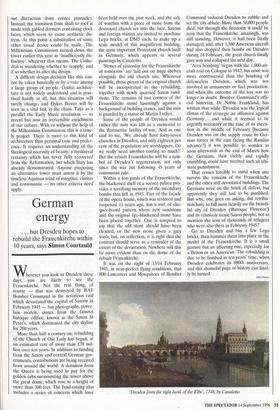German energy . .. but Dresden hopes to rebuild the
Frauenkirche within 10 years, says Simon Courtauld Wherever you look in Dresden these days, you are likely to see the Frauenkirche. Not the real thing, of course — that was destroyed by RAF Bomber Command in the notorious raid which devastated the capital of Saxony in February 1945 — but photographs, porce- lain models, stones from the famous baroque edifice, known as the Saxon St Peter's, which dominated the city skyline for 200 years.
More than half a century on, rebuilding of the Church of Our Lady has begun, at an estimated cost of more than £70 mil- lion over ten years. In addition to funding from the Saxon and central German gov- ernments, contributions are being received from around the world. A donation from the Queen is being used to pay for the golden orbs surmounting the tower above the great dome, which rose to a height of more than 300 feet. The fund-raising also includes a series of concerts which have been held over the past week, and the sale of watches with a piece of stone from the destroyed church set into the face. Saxons and foreign visitors are invited to purchase Lego bricks, at DM5 each, to make up a scale model of this magnificent building, the most important Protestant church built in Germany, which appears in several paintings by Canaletto.
'Stones of yesterday for the Frauenkirche of tomorrow' are laid out on huge shelves alongside the old church site. Wherever possible, these pieces of the original church will be incorporated in the rebuilding, together with newly quarried Saxon sand- stone. The remains of two corners of the Frauenkirche stand hauntingly against a background of building cranes, and the ruin is guarded by a statue of Martin Luther. Some of the people of Dresden would rather the ruin was left as a memorial to the destructive futility of war. And as one said to me, 'We already have forty-seven churches in Dresden, and only eighteen per cent of the population are worshippers. Do we really need another costing so much?' But the rebuilt Frauenkirche will be a sym- bol of Dresden's regeneration, not only since the war but following 45 years of communist rule.
Within a few yards of the Frauenkirche, the blackened shell of a rococo palace pro- vides a terrifying memory of the incendiary bombs that fell in 1945. Part of the façade of the opera house, which was restored and reopened 11 years ago, has a sort of che- quer-board pattern where new sandstone and the original fire-blackened stone have been placed together. One is tempted to say that the old stone should have been cleaned, or the new stone given a grey wash; but, on reflection, it is right that the contrast should serve as a reminder of the extent of the devastation. Nowhere will this be more evident than on the dome of the rebuilt Frauenkirche.
It was on the night of 13/14 February 1945, in near-perfect flying conditions, that 800 Lancasters and Mosquitoes of Bomber Command reduced Dresden to rubble and set the city ablaze. More than 50,000 people died, but through the firestorm it could be seen that the Frauenkirche, amazingly, was still standing. However, it had been fatally damaged; and, after 1,300 American aircraft had also dropped their bombs on Dresden during 14 February, the great church finally gave way and collapsed the next day.
'Area bombing' began with the 1,000-air- craft raid on Cologne in 1942, but none was more controversial than the bombing of defenceless Dresden, which was not involved in armaments or fuel production, and when the outcome of the war was no longer in doubt. Bomber Command's offi- cial historian, Dr Noble Frankland, has written that while 'Dresden was the logical climax of the strategic air offensive against Germany ... and while it seemed to be urgently necessary at the time of its execu- tion in the middle of February [because Dresden was on the supply route to Ger- man forces in the east facing the Russian advance?] it was possible to wonder as soon afterwards as the end of March how the Germans, then visibly and rapidly crumbling, could have merited such an ulti- mate punishment.'
That comes forcibly to mind when one surveys the remains of the Frauenkirche and the other still devastated buildings. The Germans were on the brink of defeat, but apparently they still had to be punished. But why, one goes on asking, did retribu- tion have to fall most heavily on the beauti- ful city of Dresden ('Baroque Florence') and its relatively irenic Saxon people, not to. mention the tens of thousands of refugees who were also there in February 1945?
Go to Dresden and buy a few Lego bricks, then hammer them into place in the model of the Frauenkirche. It is a small gesture but an affecting one, especially for a Briton or an American. The rebuilding is due to be finished in ten years' time, when Dresden celebrates its 800th anniversary, and this shameful page of history can final-
ly be turned. AKG Photo
'Dresden from the right bank of the Elbe; 1748, by Canaletto


































































 Previous page
Previous page